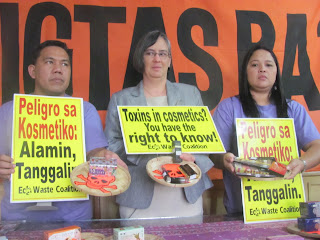Watchdog Reveals Hidden Toxins in Cosmetics, Pushes for Consumer Awareness on Health Cost of “Beauty”

Advocates for public health and safety against toxic chemicals in products and wastes are ringing out the alarm against dangerous substances in cosmetics on the market.
In a press briefing held on the eve of World Consumer Rights Day, the EcoWaste Coalition disclosed the results of the most recent screening of cosmetics it conducted using the X-Ray Fluorescence (XRF) spectrometer.
“Our latest probe on cosmetics shows that some products are downright ugly and should be quickly pulled out from store shelves. The intentional use of lead, mercury and other harmful ingredients in cosmetics is putting users and even non-users of such products, including those yet to be born, in real danger and must cease without delay,” said Aileen Lucero, Safe Cosmetics Campaigner, EcoWaste Coalition.
A visiting California-based scientist corroborated the group’s health warning saying that toxic chemicals in cosmetics “are of particular concern for women, who have both higher exposure and higher accumulation of contaminants, as well as for fetuses and children at critical windows of development.”
Speaking before the media, Dr. Ann Blake said “the test results only reinforce the need for strong cosmetics regulations that will hold manufacturers to strictest international standards, require full disclosure of product ingredients, ban acute toxic hazards and raise consumer awareness of the health cost of beauty.”
Of the 50 cosmetic products analyzed by the group, 28 were found to contain toxic metals such as antimony, lead, chromium and mercury above levels of concern.
Three lipsticks had lead with one brand (“Mengdu Express”) registering 7,062 ppm of lead way above the ASEAN limit of 20 ppm. “Mengdu Express” lipstick also had chromium at 1,070 ppm.
Eleven blush- on, eye shadow and lipstick products had mercury ranging from 2.9 to 12 ppm, while 15 skin whitening creams had mercury up to 38,500 ppm, exceeding the ASEAN, China and Philippine FDA regulatory limit of 1 ppm for mercury in cosmetics.
Shockingly, seven of these mercury-laden skin whitening creams were among the 50 products already banned by the FDA for containing mercury that “pose imminent danger or injury to the consuming public.”
None of the 28 “toxic beauty products” listed antimony, lead, chromium and mercury among their ingredients, leaving consumers in the dark about the hidden poisons in such products.
To prevent toxic exposure, the EcoWaste Coalition advises cosmetics consumers to:
1. Critically read the product information and refrain from buying unlabelled/mislabelled and unregistered cosmetics.
2. Avoid cosmetics with chemical ingredients that are hard to spell, pronounce and understand.
3. Demand safe products and be conscious of the health costs of “beauty.”
For the cosmetics industry, the EcoWaste Coalition recommends the following:
1. Remove toxic metals and other chemicals of concern in cosmetics and replace these with non-hazardous substitutes.
2. Disclose all chemical ingredients, including impurities, on the product labels and online.
3. Provide hazard labelling for products containing ingredients linked to cancer and other major health issues.




Comments